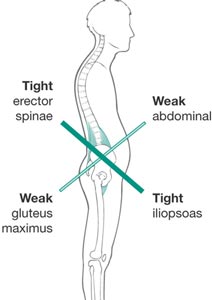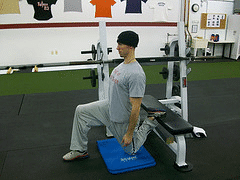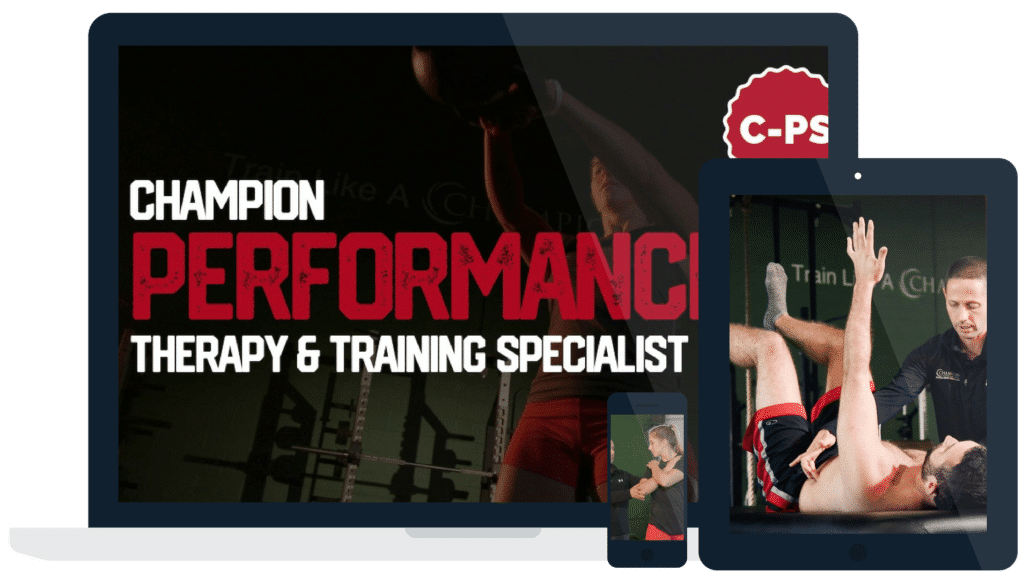Today’s guest post on Groin Injuries in Hockey Players is from Peter Nelson. Peter is currently working in collegiate hockey and has shown great interest in understanding why groin injuries are so common and what we can do about it. Peter does a great job thinking outside the box and taking a look at the bigger picture. Thanks Peter, great article, I’ll add some of my own comments at the end.
Groin Injuries in Hockey Players: An All-Too-Common Problem With a Not-So-Commonly Known Solution

Examining the Prevalence of Groin Injuries Among Hockey Players
While this relationship exists at almost all levels of the game, it has been particularly well documented in elite players. Several studies have been conducted to assess the prevalence of this specific injury at the professional level. The results have been consistent, and they are troubling.
A 1978 study by Sim et al. concluded that “ice hockey players are at high risk for noncontact musculoskeletal injuries because of the excessive force generated during the acceleration and deceleration phases of skating.”
A 1997 study by Molsa et al. reported that 43% of muscle strains in elite Finnish hockey players were involving the groin region.
A 1999 study by Emery et al. found that “the impact of groin and abdominal strain injury at an elite level of play in hockey is significant and increasing.” According to their data, the rate of groin/abdominal strains in the NHL increased from about 13 injuries per 100 players per year during the 1991-1992 season to almost 20 injuries per 100 players per year during the 1996-1997 season. Furthermore, the recurrence rate was 23.5%, meaning that injuries of this nature went on to plague a significant percentage of players for an extended period of time.
More recently, a study by Tyler et al. found that out of 9 NHL players evaluated, all of whom had suffered from groin injuries, four had sustained multiple strains.
The Long and Short of Groin Injuries: Muscular Imbalances in Athletes
With the strong correlation between hockey players and groin injuries established, it becomes important to understand why this is the case. Many would be quick to attribute it to the violent nature of the sport, but research indicates that this is unfounded. The study by Emery et al. found that upwards of 90% of all groin injuries were non-contact in nature. Others posit that strains are due to the muscles involved being too short and lacking flexibility.
Sports physicians, physiotherapists, and strength coaches who fall under this category often prescribe stretching of the groin musculature to remedy the issue. The study by Tyler et al., however, found that preseason flexibility of the hip adductors, the primary muscles that make up the groin region, did not differ between NHL players who went on to sustain groin strains and those who did not. This indicates that stretching of the groin is probably not an effective approach toward preventing or treating this type of injury.
What the Tyler et al. study did find was that preseason hip adduction strength of the players who sustained groin injuries was 18% lower than that of the healthy players. They also found that adduction strength was 95% of abduction strength in the uninjured players, compared to only 78% in the injured players. This suggests that a muscular imbalance between the weak adductors and the relatively strong abductors plays a large role in groin issues. The Sim et al. study also supports this view, suggesting that “in ice hockey players, adductor strains may be caused by the eccentric force of the adductors attempting to decelerate the leg during a stride.” The researchers further went on to state that “a strength imbalance between the propulsive muscles and stabilizing muscles has been proposed as a mechanism for adductor muscle strains in athletes.”
Detective Work: Delving Deeper to Identify the Root of the Problem
The logical conclusion then should be that the solution is to strengthen the adductors and stretch the abductors, right? Well, yes, but a more in-depth look at the problem is necessary to determine exactly why this imbalance is present in the first place, that way we can most effectively remedy the issue. As a sports physician, physical therapist, or strength coach, you are not truly solving the problem unless you address the root cause.
In order to identify the root cause, it is important to first consider three main concepts. First, it is imperative to understand the biomechanics of skating. This brief excerpt from the study by Sim et al. sums it up very well:
“During the powerful skating stride the hip extensors and abductors are the prime movers, while the hip flexors and adductors act to stabilize the hip and decelerate the limb.”

Consequently, since the hip flexors pull the pelvis down from the front and the spinal erectors pull the pelvis up from the back, the pelvis becomes tilted anteriorly. This lengthens the hamstrings, putting them at a leverage advantage and forcing them to take on more of the load in extending the hips than the glutes. The glutes then become relatively weak, as does the anterior core. The end result is a player with what Janda called “lower-crossed syndrome”, illustrated below, who is at risk for both low back and hamstring injuries.
How does this play into groin injuries? In order to make that connection, you need to understand the third concept, which is a central tenet of the Postural Restoration Institute (PRI): while muscles are often prime movers in a single plane, they must actually be considered as having an effect on movement in all three planes—sagittal, frontal, and transverse.
The perfect example of this is the hip extensors. While the hip extensors are mostly responsible for movement generated in the sagittal plane, these same muscles—most notably the gluteus maximus—function as external rotators and abductors. This is relevant to hockey because the nature of a skating stride requires players to have strong abductors—they are prime movers in this movement—as well as spend a lot of time in external rotation. This tightens both the external rotators and abductors and pulls the hips into chronic external rotation and abduction, or in other words causes them to become “flared”. Adductor muscles like the adductor magnus, which also contribute to internal rotation, become lengthened and, like the hamstrings in the sagittal plane, are put at risk for injury. This clearly fits the theory of a muscle imbalance as the potential contributor to groin injuries, and it becomes clear from the analysis above that pelvic alignment is important in understanding the root cause of this imbalance.
It also makes it apparent that stretching the groin is not only ineffective; it can actually feed right into the problem!
Shifting Into Neutral: Correcting Pelvic Positioning
That brings us to the million-dollar question: how do we fix it? After coming to the understanding that groin issues are caused by pelvic misalignment in all three planes of movement, you can see why I suggested that strengthening the internal rotators and stretching the external rotators is not a comprehensive solution to the problem. We must address muscular imbalances with the triplanar perspective in order to effectively prevent injuries of this nature.
The first plan of attack should be to rectify the imbalances in the sagittal plane. The reason being is simply that extension limits rotation, and since I already explained that hockey players—and athletes in general—tend to live in chronic extension, it makes sense to resolve that problem first in order to maximize the effectiveness of attempts at repositioning an athlete in the other two planes. I group the frontal plane with the transverse plane, even though I am talking about rotation being limited, because there is significant overlap between the prime movers in abduction/adduction and internal/external rotation.
Addressing the imbalances in the sagittal plane is fairly straightforward. I like the approach Mike Robertson takes in identifying two “force couples”. The posterior force couple consists of the anterior core and the posterior chain (primarily the glutes and hamstrings), and these two will be weak in athletes living in extension, as I previously mentioned. Hammering the glutes and hamstrings with exercises like hip thrusts (demonstrated by Bret Contreras below) and Romanian Deadlifts, respectively, will strengthen the posterior chain and tilt the hips posteriorly by pulling them down from the back, the net result being a more neutral alignment since the athlete was in anterior tilt to begin with. With the anterior core, it is important to note that it is the internal obliques, external obliques, and transverse abdominis that are usually weak, as opposed to the rectus abdominis. Strengthening these muscles will tilt the hips posteriorly by pulling them up from the front, also resulting in a more neutral alignment.
The anterior force couple consists of the spinal erectors and the hip flexors, and these two will be tight. Stretching the hip flexors is crucial; this can be accomplished with stretches like the Bench Hip Flexor Stretch, illustrated by Tony Gentilcore. Self-myofascial release can also be useful.
With the Bench Hip Flexor Stretch, the harder the athlete squeezes the glutes and extends at the hips, the greater the stretch on the rectus femoris. Be careful, however, not to allow the athlete to extend at the lumbar spine, as this reinforces the incorrect movement pattern we are trying to move away from.
Stretching the spinal erectors can be accomplished with “prayer position”-type stretches. Self-myofascial release with a lacrosse ball peanut can also be effective. In working with Head Strength Coach Rob McLean and the Pennsylvania State University Men’s Ice Hockey team, we tend to use exercises with movement patterns that inhibit the paraspinals while also activating the anterior core, such as the exercise from the Postural Restoration Institute shown below, demonstrated by Kevin Neeld.
In this case, we are killing two birds with one stone in strengthening the weak muscles and teaching the athletes to inhibit the tight muscles (notice how Kevin’s back is rounded; this helps to inhibit the spinal erectors) at the same time. You can also see that in the video there is a ball between Kevin’s knees—this is to activate the internal rotators/adductors, which I will discuss next.
Addressing the frontal and transverse planes when it comes to fixing pelvic alignment is overlooked too often. Again, we want to strengthen the internal rotators and adductors—the muscles might largely overlap but it is important to pattern both movements individually—and stretch the external rotators and abductors. For internal/external rotation, med ball crushes is a good one to strengthen internal rotation (note that this exercise can also pattern the adduction movement, depending on how it is performed), and knee-to-knee mobilization is good for both activating the internal rotators and stretching the external rotators. Any exercises that target the semimembranosus (the most medial hamstring muscle) will also help strengthen the internal rotation movement. An easy modification to an already great exercise, which I mentioned earlier, that will help in this regard is having athletes internally rotate the legs during the hip thrust. Here at Penn State we have started doing band-resisted hip thrusts with internal rotation, and Coach McLean and I both like how it hits the internal rotators. Considering that it also strengthens the posterior chain, you’re really killing two birds with one stone in repositioning the pelvis with this small tweak.
There are also a number of good exercises for patterning and strengthening the adduction movement. Adductor Side Bridges, demonstrated below by Kevin Neeld, are great in this regard.
The adductor pullback exercise from PRI, demonstrated below also by Kevin Neeld, is another good one.
We have our players perform the adductor pullback exercise only on the left side (so they would be lying on their right side, as Kevin is in the video) to address the left AIC alignment that I mentioned earlier. Doing the opposite by lying on your left side and shifting your right hip forward and externally rotating it (since the right leg tends to be internally rotated) also helps correct this particular alignment.
Conclusion
Simply put, pelvic positioning is an important piece in preventing groin injuries, which affect athletes in all sports, but are especially a problem amongst hockey players. The three main concepts to remember in assessing pelvic positioning in any athlete are 1) understanding the biomechanics of the sport, 2) identifying the effects these movements have on the muscles involved, and 3) considering muscles as contributors to movement in all three planes, even if they are not prime movers in one or more of those planes. These concepts can be applied in order to identify imbalances in an athlete and the effects they have on the position of the pelvis. Once this is accomplished, a program can be designed so that the imbalances can be corrected and the pelvis returned to neutral. After all, neutral is where we want our athletes to be, as that puts them at the lowest risk for injury. And any reputable strength coach knows that keeping athletes healthy is the primary objective in any program. You can’t translate gains in strength and power to the playing field if you’re stuck on the sidelines.
Mike’s Thoughts
I think Peter did a great job with this article, highlighting the need to start thinking about alignment and triplanar function of the body. These are often missed in our critical thinking. The only thing I would add to this great article is that the real goal of working to enhance alignment is to then allow you to train the body in better neutrality. We may not function in neutral, but you don’t want to be stuck in our poor alignment. You want to be able to get out of your asymmetry when needed.
Every athlete I have worked with that is “stuck” in their asymmetry is prone to recurrent injuries. We’ve all had them, right? The person that just keeps straining their groin, or hamstring, etc. Take a step back and think of the 3 principles that Peter summarizes in his conclusion.
If you like information like this, I’ve discussed concepts like triplanar training of the glutes. These are some of the fundamental principles in my Functional Stability Training of the Lower Body program with Eric Cressey. We discuss a lot of concepts related to alignment, triplanar function of the body, and training the body in 3D.
About the Author
Peter Nelson is a Strength and Conditioning Staff Intern with the Pennsylvania State University Men’s Ice Hockey Team. He graduated in 2012 from Phillips Academy Andover, and is currently a sophomore at Penn State’s University Park Campus. Peter is a former competitive hockey player, having played for Andover’s Varsity Hockey Team for three years in Division 1 of the New England Prep School Ice Hockey Association. While he no longer plays competitively, his longtime involvement in sports has driven his interest in research fields such as nutrition and strength and conditioning. He has previously interned at NIKE SPARQ-affiliated Athletic Evolution in Woburn, MA. Peter is greatly looking forward to continuing to work under Head Strength and Conditioning Coach Robert McLean of the Penn State Men’s Hockey Team and continuing his education in pursuing a career in the health and fitness realm.
Note: I’d like to thank Coach Rob McLean, Head Strength and Conditioning Coach for the Pennsylvania State University Men’s Ice Hockey Team, for taking me under his wing and introducing me to and helping me understand important concepts like those presented by the Postural Restoration Institute. Much of this article reflects what I have learned over the course of the past year while working with him and the hockey team as an intern. I sincerely appreciate the opportunity.
Referenses
- Sim FH, Simonet WT, Melton LJ III, et al: Ice hockey injuries. Am J SportsMed 15: 30–40, 1987.
- Molsa J, Airaksinen O, Näsman O, Torstila I. Ice hockey injuries in Finland: a prospective epidemiologic study. Am J Sports Med. 1997;25(4):495-499.
- Emery CA, Meeuwisse WH, Powell JW. Groin and abdominal strain injuries in the National Hockey League.. Clin J Sport Med. 1999;9(3):151-156.
- Tyler TF, Nicholas SJ, Campbell RJ, McHugh MP. The association of hip strength and flexibility on the incidence of groin strains in professional ice hockey players. Am J Sports Med. 2001;29(2):124-128.
- Robertson, Mike. March 3, 2007. “Hips Don’t Lie: Fixing Your Force Couples.” T Nation.








